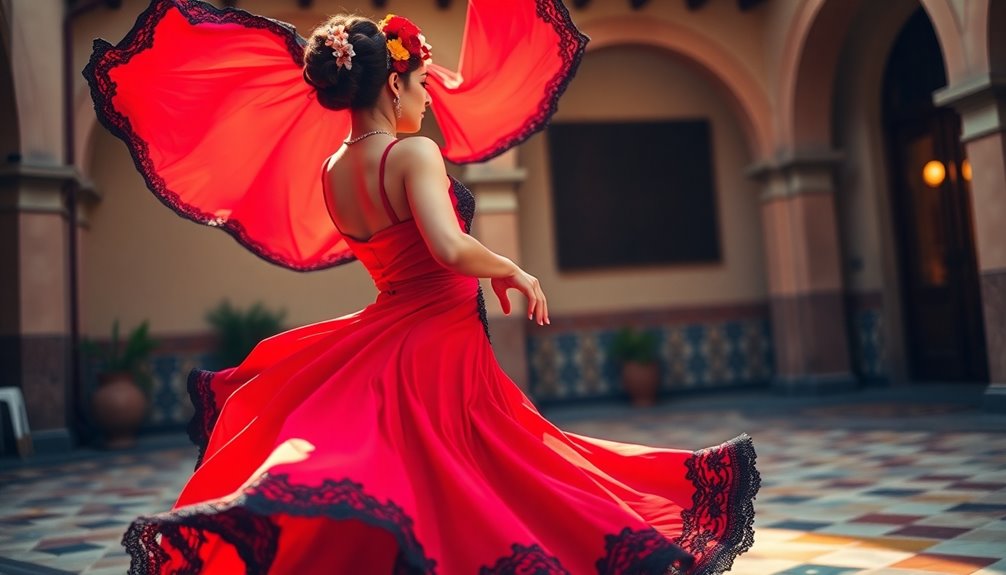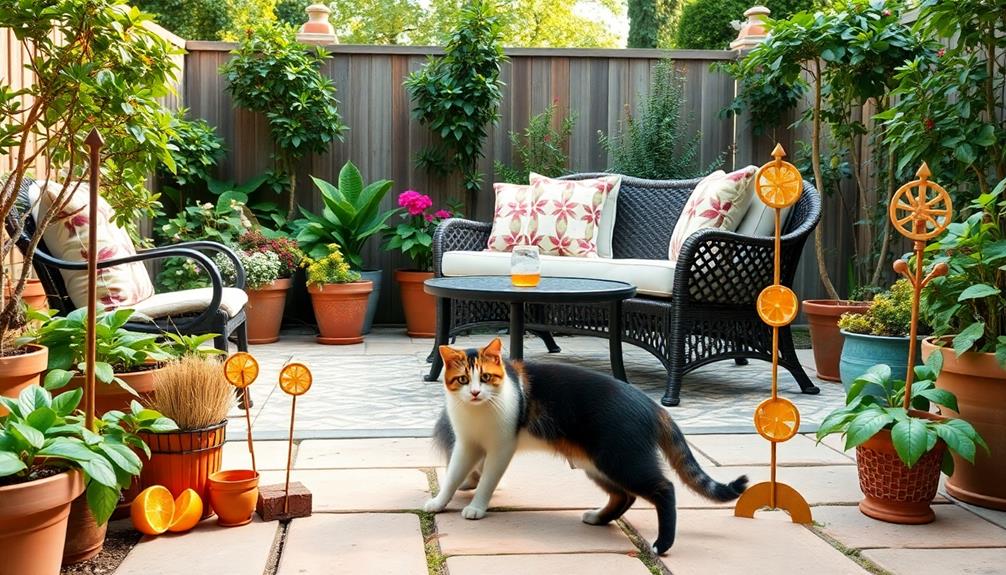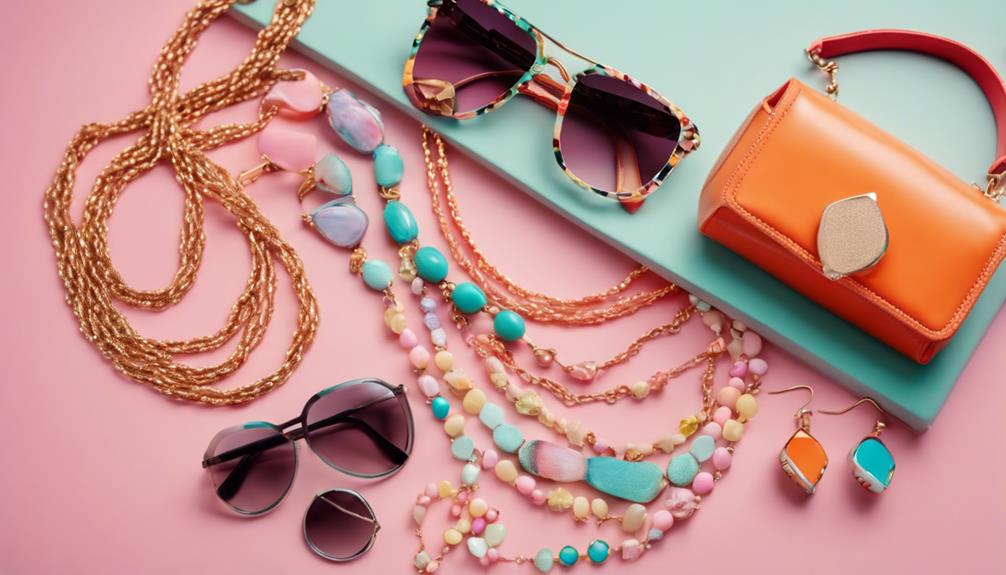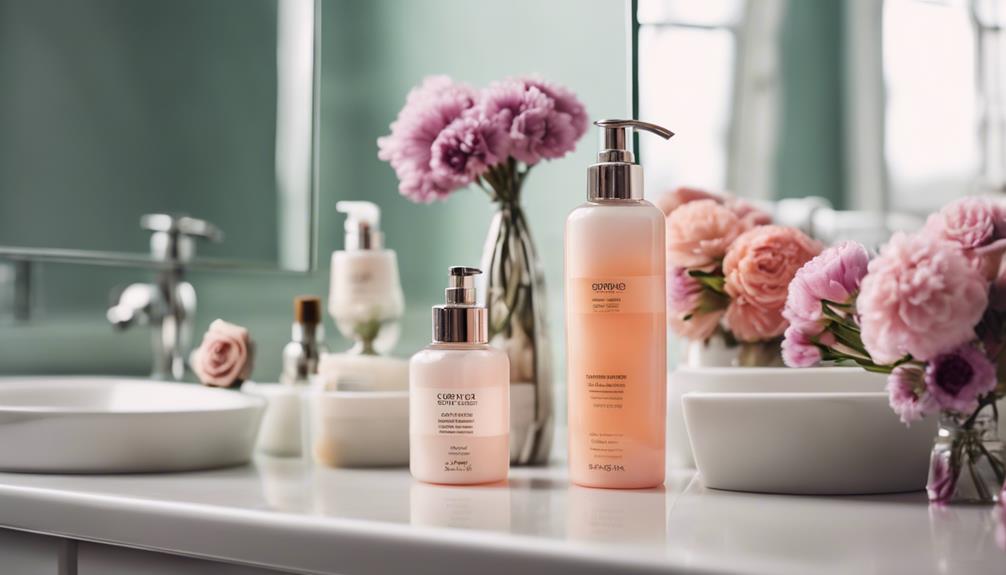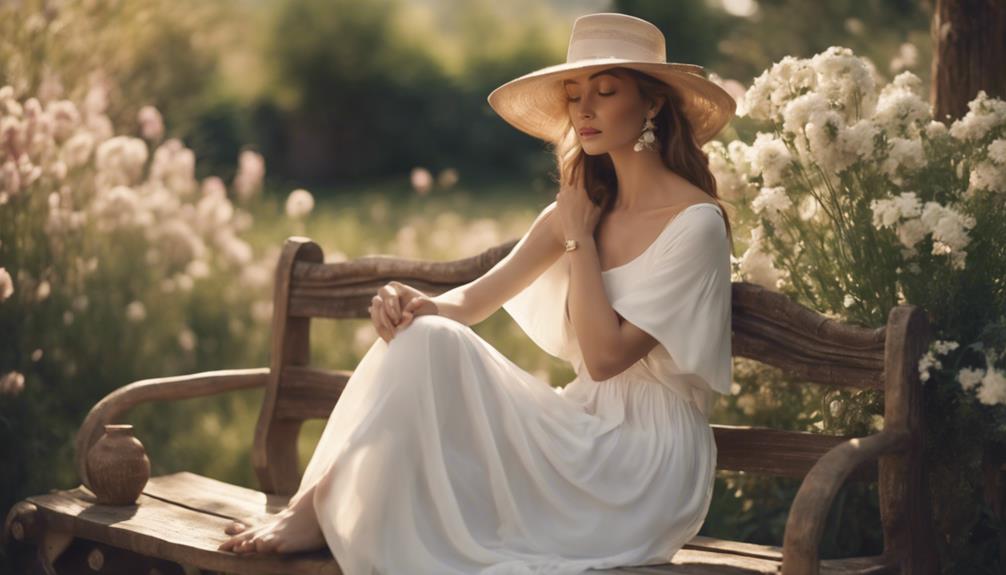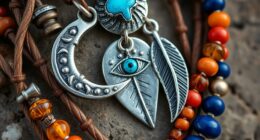Spanish attire radiates cultural elegance, offering you a vibrant blend of history and art. With stunning elements like flamenco dresses, intricate embroidery, and luxurious fabrics, your outfit can make a powerful statement. Accessories such as the peineta or mantón de Manila enhance your look, adding authenticity and flair. Modern designers are embracing sustainability while keeping the traditional spirit alive, giving you choices that reflect both personality and values. Plus, personalizing your attire allows for unique expression rooted in regional pride. To discover more about crafting your own Spanish look, there's plenty more to explore!
Key Takeaways
- Spanish attire combines rich historical influences, showcasing vibrant colors and intricate designs that reflect cultural identity and elegance.
- Traditional garments like the flamenco dress and mantilla symbolize social status and regional pride, enhancing their cultural significance.
- Modern Spanish fashion embraces sustainability, with brands creating eco-friendly pieces that merge traditional aesthetics with contemporary trends.
- Personalized embroidery options allow individuals to express their unique identities while honoring regional traditions through intricate craftsmanship.
- Spanish fashion serves as a platform for feminist activism, promoting women's empowerment and challenging societal norms through contemporary design.
Origin and historical background of the fashion trend/style
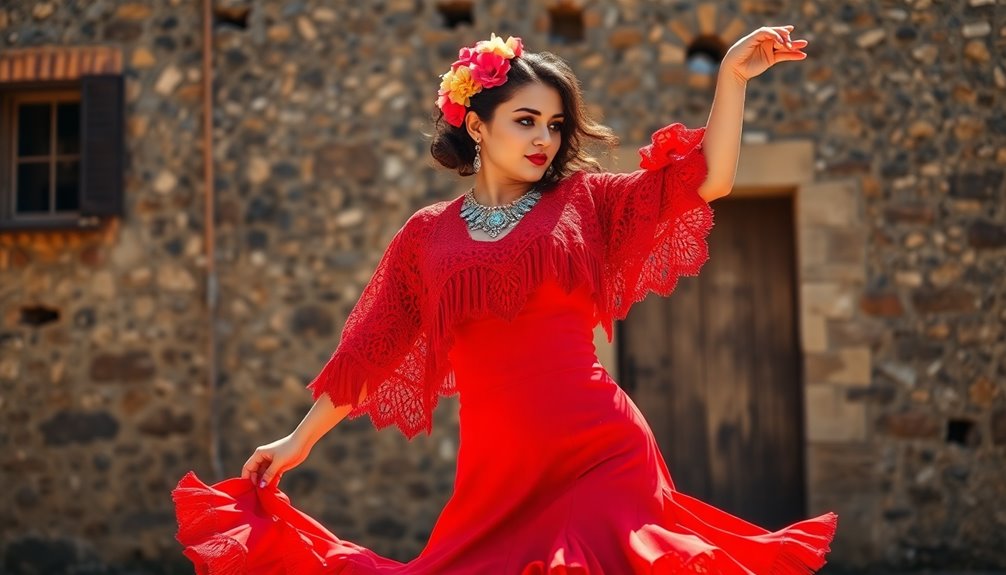
Spanish attire has undergone a fascinating transformation over the centuries, shaped by royal patronage and cultural influences.
As you explore its evolution, you'll notice how garments reflect not just fashion trends but also the rich history of Spain itself.
Understanding these changes gives you a deeper appreciation for the vibrant styles seen today.
Historical Transformation of Fashion
Since the 16th century, Spain's fashion landscape has undergone remarkable transformations, shaped by the rich tapestry of cultures present during the nation's Golden Age. Spanish traditional attire incorporated elements from Moorish, Latin, and Roman styles, reflecting the diverse cultural identity of the nation. Garments like the mantilla and traje de luces emerged not only from practical needs but also as symbols of social status, showcasing regional identities and class distinctions.
Following the end of Franco's dictatorship in 1975, Spain experienced a cultural renaissance, igniting the La Movida movement. This period celebrated vibrant and expressive fashion trends as a means of self-identity, pushing the boundaries of traditional attire. Festivals like Las Fallas and San Isidro became pivotal, serving as platforms to reinforce community ties and showcase the country's rich cultural heritage through dress.
Influential designers such as Cristóbal Balenciaga and Paco Rabanne played crucial roles in this historical transformation, merging traditional elements with modern aesthetics. Their work not only reshaped Spanish fashion but also left a lasting impact on global fashion trends, ensuring that Spain remains a vital player in the conversation about style and identity.
Spanish Royal Patronage
Throughout history, royal patronage has profoundly influenced fashion trends, especially in Spain, where monarchs like Queen Isabella I set the stage for opulent styles. The Spanish royal court of the 16th century emerged as a fashion hub, showcasing luxurious fabrics and intricate designs that often drew inspiration from Moorish and Italian influences.
This era marked the solidification of traditional clothing, such as the mantilla and traje de luces, as symbols of cultural pride and elegance. By endorsing specific garments and materials, Spanish royals not only defined their own status but also impacted broader fashion trends across Europe.
Their preference for high-quality textiles, including silk and brocade, transformed textile production, making these luxurious fabrics staples in both royal and common wardrobes.
Today, modern Spanish designers continue to pay homage to this rich heritage, incorporating historical elements into contemporary fashion. By doing so, they maintain the legacy of Spanish royal patronage, reminding us of the enduring elegance and cultural significance of these styles.
Key Characteristics
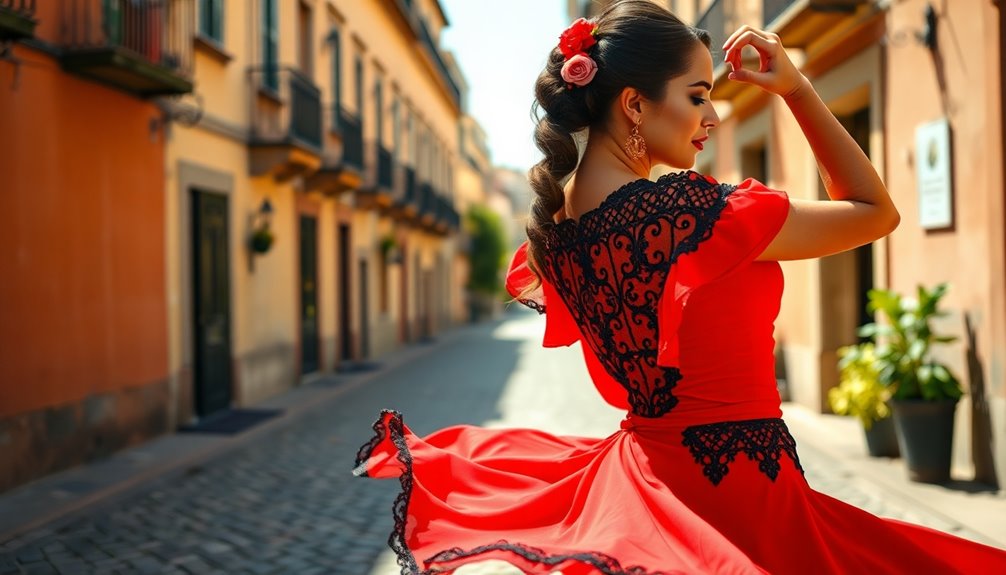
When you think of Spanish attire, vibrant embroidery and lace immediately come to mind.
The rich silk and bold hues make each piece stand out, capturing the eye and spirit of the culture.
You'll also notice signature embroidered shawls that add a touch of elegance and tradition to any outfit.
Vibrant Embroidery and Lace
In the heart of Spanish traditional attire lies vibrant embroidery and exquisite lace, elements that not only enhance the visual appeal but also embody the rich cultural heritage of the country. When you look closely at garments like the flamenco dress, you'll notice intricate designs bursting with vibrant colors that reflect the diverse regions of Spain. Each stitch and pattern tells a story, showcasing the artistry and cultural significance behind the attire.
Lace, particularly in the form of mantillas, adds an air of elegance and refinement to traditional clothing. The delicate patterns enhance the overall aesthetic, making each ensemble a work of art.
Take the traje de fallera, for instance; its elaborate embroidery represents local traditions and identities, with artisans dedicating hours to create these stunning pieces.
Regional costumes, such as the Hereu and Pubilla from Cataluña, incorporate unique lace and embroidery details, celebrating cultural pride and diversity within Spanish fashion.
Accessories like the peineta and mantón de Manila further elevate the look, featuring intricate lacework that complements embroidered garments, adding texture and sophistication to your traditional attire.
Rich Silk and Vibrant Hues
Spanish attire captivates with its rich silk fabrics and vibrant hues, creating a stunning visual experience. The luxurious feel of silk enhances the elegance of traditional garments, making every piece a striking statement.
Flamenco dresses, in particular, are renowned for their bold colors—think fiery reds, sunny yellows, and lush greens. These vibrant hues aren't just pretty; they symbolize passion and cultural pride, reflecting the spirit of Spain.
Intricate embroidery adorns these garments, showcasing unique designs that celebrate regional identities. Floral motifs and other patterns offer a glimpse into Spain's diverse heritage, with each region bringing its own flair to the fabric.
For instance, Andalusia favors lively shades that resonate with its vibrant culture, while northern areas might lean towards more muted tones.
Accessories like the mantón de Manila, crafted from rich silk and embellished with colorful embroidery, further elevate these outfits. They contribute to the overall vibrancy and richness, creating a complete look that's steeped in tradition.
Whether you're attending a festival or simply embracing the essence of Spanish culture, the combination of rich silk and vibrant hues is sure to make you feel connected to this beautiful heritage.
Signature Embroidered Shawls
Richly adorned and skillfully crafted, signature embroidered shawls known as mantones de Manila stand out as essential elements of traditional Spanish attire. Made from luxurious silk or cotton, these shawls showcase intricate floral patterns that reflect the artistry of Spanish craftsmanship. The vibrant colors and elaborate embroidery not only highlight regional motifs but also celebrate cultural heritage, making mantones de Manila indispensable for any wardrobe.
You'll often see these shawls draped elegantly over the shoulders during cultural events and festivals, enhancing outfits like flamenco dresses. Their historical significance adds depth; originally imported from the Philippines, they gained popularity in 19th-century Spain, symbolizing a beautiful fusion of Asian and Spanish aesthetics.
Pairing the mantón de Manila with accessories like the peineta further elevates its traditional appeal, cementing its role as a key element in Spanish women's fashion.
When you wear a mantón de Manila, you're not just donning a shawl; you're embracing a piece of history and artistry that makes a bold statement about cultural elegance.
Modern Interpretation
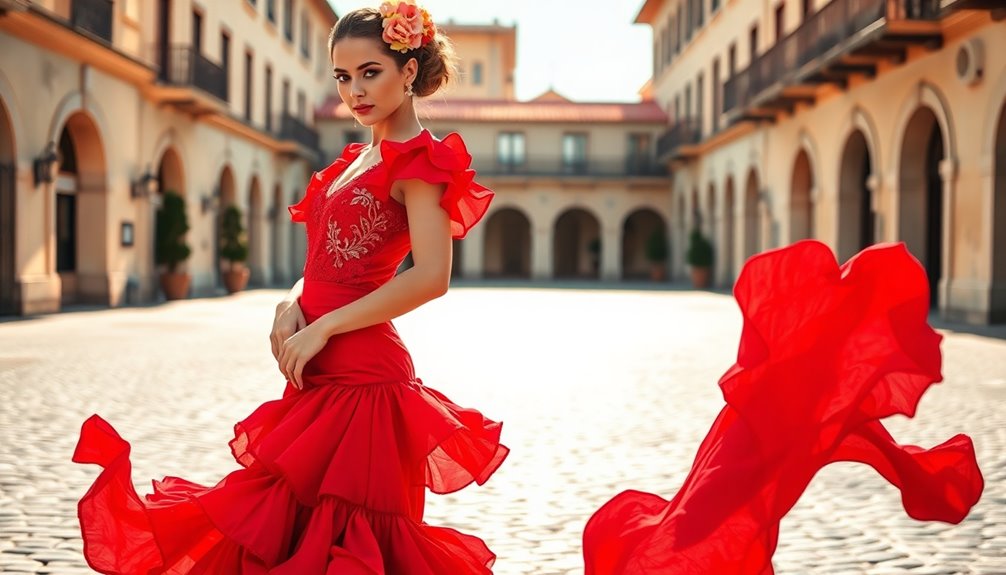
You'll find that modern interpretations of Spanish attire are increasingly leaning towards sustainable fashion practices, showcasing eco-friendly materials and ethical production methods.
Emerging Spanish fashion labels are stepping up, blending traditional styles with innovative designs that reflect today's values.
Plus, fashion-forward Spanish icons are embracing these trends, making cultural heritage both stylish and relevant.
Sustainable Fashion Practices Emerging
Increasingly, sustainable fashion practices are reshaping the landscape of Spain's clothing industry. You'll notice brands like Ecoalf and Thinking Mu leading the charge by utilizing recycled materials, significantly reducing waste in their production processes.
Ethical sourcing has become a priority, with many companies ensuring transparency in their supply chains and promoting fair labor practices.
As you explore this evolving scene, you'll find eco-conscious designers blending traditional techniques with modern flair. They incorporate artisan craftsmanship and organic fabrics to create innovative designs that pay homage to classic Spanish attire while being environmentally responsible.
Fashion events, such as Madrid Fashion Week, now showcase dedicated segments for sustainable fashion, highlighting the growing importance of eco-friendly practices within the industry.
Additionally, the rise of second-hand and vintage markets reflects a shift in consumer preferences toward sustainability. Platforms like Vinted and Wallapop play a crucial role in facilitating the circular fashion economy, allowing you to shop more mindfully.
Emerging Spanish Fashion Labels
Emerging Spanish fashion labels are transforming the industry with their innovative approaches that marry traditional craftsmanship with contemporary styles. Brands like Delaostia and The 2nd Skin Co are gaining recognition for their unique designs, emphasizing sustainability and ethical production practices.
With a focus on cultural heritage, these labels create pieces that resonate with a global audience, blending history with modern aesthetics.
Aloha from Deer captures youthful energy with its vibrant prints and playful designs, showcasing Spain's cultural richness through streetwear. Meanwhile, Sita Murt stands out for crafting timeless, elegant pieces that highlight the quality of Spanish craftsmanship, using luxurious fabrics and minimalist designs that appeal to a sophisticated market.
Ze García further exemplifies this trend by combining traditional Spanish elements with modern silhouettes, offering versatile clothing that reflects both cultural heritage and current fashion trends.
The rise of these emerging labels signals a broader movement in Spanish fashion towards individuality and self-expression, as designers draw inspiration from regional styles and historical influences.
As you explore these labels, you'll appreciate how they redefine Spanish fashion for today's discerning consumers, making a bold statement on the global stage.
Fashion-Forward Spanish Icons
Spanish fashion icons like Penelope Cruz and Rosalía effortlessly blend tradition with modernity, showcasing styles that celebrate the country's rich cultural heritage. Their looks often incorporate vibrant colors and intricate designs reminiscent of traditional dress, proving that cultural clothing can thrive in contemporary settings.
You can see how they redefine Spanish fashion, making it accessible and appealing to a global audience.
Gala Gonzalez, another notable figure, exemplifies this fusion by mixing high fashion with vintage pieces, crafting a unique aesthetic that honors both modernity and tradition.
Renowned fashion designers like Loewe and Agatha Ruiz de la Prada play a pivotal role in this narrative, infusing bold designs and rich cultural motifs into their collections, further asserting Spain's identity on the international stage.
The rise of fast fashion brands like Zara has also revolutionized accessibility, allowing you to incorporate Spanish cultural elements into your everyday wear without sacrificing style.
Events like Madrid Fashion Week serve as essential platforms, showcasing innovative designs that reinterpret traditional attire while emphasizing sustainability and cultural narratives. Designers use this platform to push the boundaries of creativity, blending modern aesthetics with age-old craftsmanship. Through captivating presentations, trends emerge that influence the global fashion landscape, prompting a shift towards more sustainable practices. Among the standout items this season are the red becks fashion statement pieces, which meld vibrant colors with sustainable fabrics, making a bold declaration of style and responsibility.
Embracing these fashion-forward icons means celebrating a harmonious blend of the old and new in Spanish attire.
Styling Tips
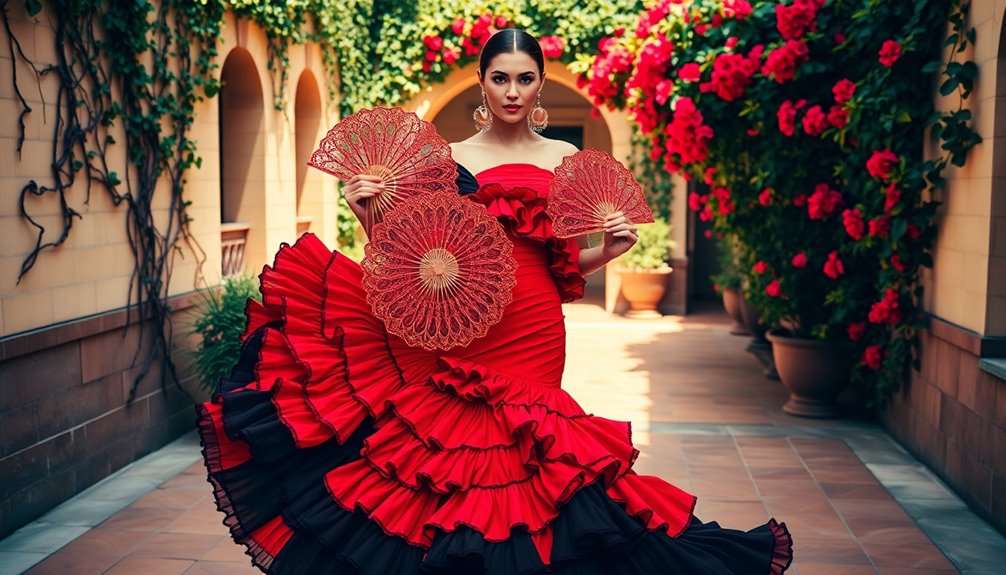
When you're putting together your Spanish-inspired outfit, think about essential accessories that can elevate your look.
Incorporate flamenco-inspired pieces and layer traditional items for a chic touch.
These styling tips will help you celebrate the rich cultural heritage while expressing your unique flair. Additionally, consider incorporating hydrating face masks to ensure your skin looks radiant and complements your outfit beautifully.
Essential Spanish Accessories
There's no denying that the right accessories can elevate your outfit, especially when drawing inspiration from traditional Spanish styles. To truly capture the essence of Spanish elegance, consider incorporating a mantilla—a delicate lace or silk veil that pairs beautifully with a peineta, adding sophistication to both traditional and modern looks.
Espadrilles are another essential accessory, offering comfort and style with their jute and canvas design. They're perfect for complementing summer dresses or casual ensembles, ensuring you stay chic while enjoying warm weather.
Don't forget statement jewelry; ornate earrings and rosario beads provide a cultural touch that enhances traditional attire while reflecting Spain's rich artistic heritage.
A vibrant fan (abanico) isn't just practical for keeping cool; it also adds a stylish flair to your outfit. Look for intricate designs that showcase regional craftsmanship.
Lastly, consider wide-brimmed hats like the sombrero cordobés. These hats are essential for sun protection and nod to traditional Spanish fashion, making them ideal for festive occasions.
With these accessories, you can effortlessly blend traditional elegance with modern flair, ensuring your outfit makes a statement.
Flamenco-Inspired Ensemble Suggestions
Flamenco-inspired ensembles often showcase vibrant colors and intricate details that truly capture the spirit of this passionate dance. To create your own flamenco look, start with a striking flamenco dress (traje de flamenca). Opt for ruffled skirts and sleeves, choosing bold polka dots or floral patterns that exude festivity.
Accessorize thoughtfully to enhance your outfit's cultural significance. A mantón de Manila, with its rich embroidery, adds both elegance and a traditional touch. Incorporate statement pieces like a peineta, a decorative comb, and fresh flowers in your hair to embody the flamenco spirit fully. These elements lend authenticity and flair to your ensemble.
Don't forget the shoes! Choose flamenco shoes (taconeo) featuring sturdy heels that ensure style and functionality, perfect for dancing or social gatherings.
If you want to accentuate your silhouette further, consider layering with a fitted bodice or corset, reflecting the historical influences of flamenco attire while modernizing your look. By embracing these styling tips, you'll create a vibrant flamenco-inspired ensemble that celebrates both tradition and personal expression.
Layering Traditional Pieces
Layering traditional Spanish pieces adds depth and character to your outfit, allowing you to showcase cultural heritage while expressing your unique style.
Start with a vibrant flamenco dress as your foundation. Then, consider draping a mantón de Manila over your shoulders to enhance elegance and cultural significance. This combination creates a visually striking look.
You can also incorporate a modern tailored jacket over a traditional traje de flamenca, adding a contemporary flair while keeping the vibrant essence intact.
Accessories play a crucial role in elevating your ensemble; using a peineta atop a mantilla adds dimension and sophistication.
Don't shy away from mixing regional garments. Pairing a Chulapa skirt with a Basque txapela showcases the rich diversity of Spanish culture, creating a unique style statement.
To emphasize layers, combine different textures; the lace from a mantilla beautifully contrasts with the ruffles of a flamenco dress, enhancing depth and interest.
Shopping Guide
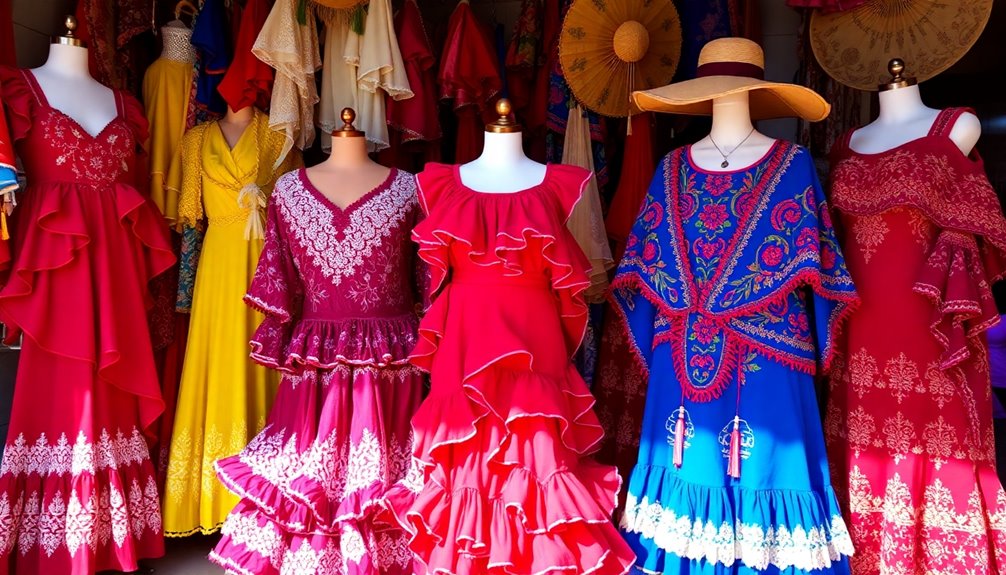
When you're shopping for traditional Spanish attire, focus on finding unique pieces that truly reflect the culture. Start your search with flamenco dresses, or trajes de flamenca, which are celebrated for their flounces and vibrant colors. You'll find these stunning dresses in local boutiques and specialty shops throughout Andalusia.
Don't miss regional markets and festivals, like Las Fallas in Valencia, where you can purchase authentic Fallero and Fallera costumes directly from artisans. This ensures you get pieces that embody cultural authenticity.
For a modern twist, check out major Spanish fashion retailers like Zara and Mango, which offer stylish interpretations of traditional attire that incorporate Spanish cultural elements.
To complete your look, seek out authentic accessories such as mantillas and peinetas made by local craftspeople. These delicate lace veils and decorative combs are essential for achieving an authentic appearance, especially during religious ceremonies.
If you're looking for convenience, explore online platforms specializing in Spanish fashion, where you can discover a wide range of traditional and modern styles, ensuring you can find unique pieces no matter where you are.
Handcrafted Embellishments and Techniques
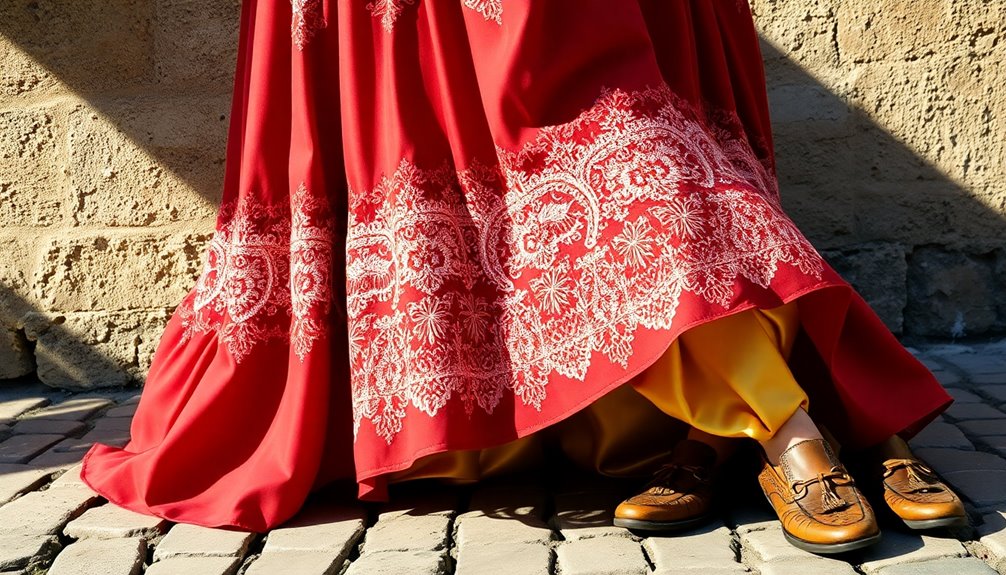
When you explore Spanish attire, you'll find a world of handcrafted textile projects that reflect rich traditions.
Personalized embroidery options allow you to add your unique touch, making each piece truly one-of-a-kind.
Embracing these techniques can turn your clothing into a stunning representation of Spanish artistry and culture.
Handmade Spanish Textile Projects
Handmade Spanish textile projects blend time-honored techniques with vibrant designs that capture the essence of the culture. These projects often showcase traditional techniques like embroidery, weaving, and lace-making, passed down through generations.
You'll find that techniques such as "bordado" are essential for creating intricate designs on garments, often featuring floral motifs that celebrate the beauty of Spanish culture.
One standout example is the "mantón de Manila," a hand-embroidered shawl that highlights elaborate stitching techniques. This piece not only serves as a popular accessory during cultural festivities but also demonstrates the craftsmanship that goes into handmade textiles.
Spanish artisans frequently use natural fibers like cotton and linen, ensuring that their creations are sustainable while enhancing durability and quality.
The artistry involved in these handmade projects is celebrated in local festivals, where artisans proudly display their work and promote the preservation of traditional methods.
Personalized Embroidery Options
Personalized embroidery options in Spanish attire offer a vibrant way to express individuality and cultural pride. You can choose from intricate designs that reflect regional traditions, like the floral patterns commonly seen in flamenco dresses.
These handcrafted embellishments allow you to add a unique touch to your traditional garments, making them truly one-of-a-kind.
One popular technique is "bordado a mano," where skilled artisans use needle and thread to create detailed embroidery, enhancing the garment's individuality.
You might also consider "aplique," a method that layers fabric to create textured designs, adding depth and visual interest to your attire.
Customizable embroidery services are increasingly available, letting you incorporate initials, dates, or symbols that hold personal significance.
Cultural Impact
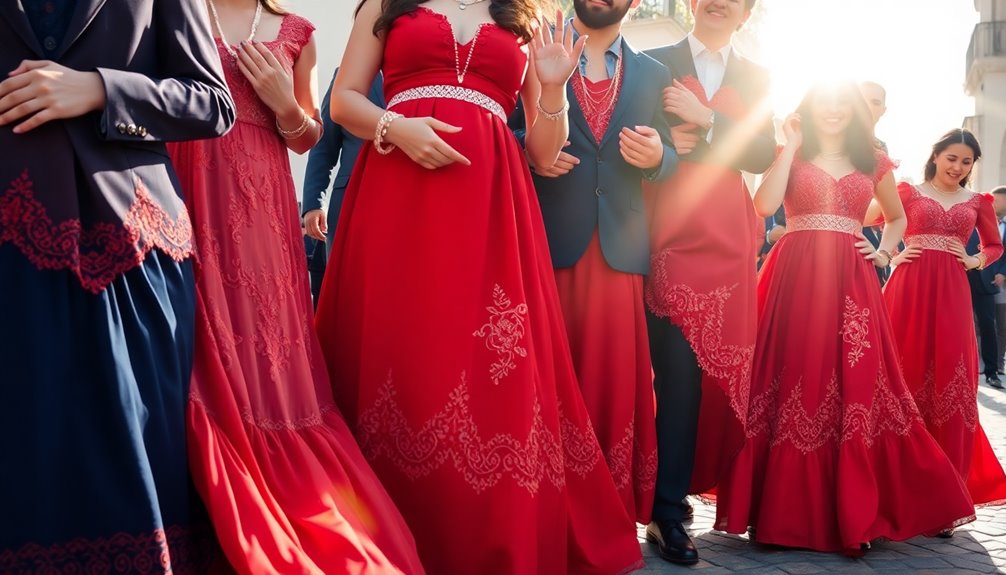
When you think about Spanish attire, it's hard not to notice its influence in film costumes and fashion, which often highlight the rich cultural narratives of Spain.
This connection extends to fashion's role in feminist activism, where traditional garments are reinterpreted to challenge norms and celebrate women's empowerment.
As you explore these themes, you'll see how Spanish clothing continues to shape and reflect societal values.
Film Costumes and Fashion
Film costumes in Spanish cinema not only enhance storytelling but also serve as a vibrant reflection of the country's cultural heritage. Through the use of traditional attire like flamenco dresses and mantillas, these costumes bring authenticity to the screen, allowing you to connect deeply with the characters and their emotions.
Iconic films such as "Carmen" and "The Flower of My Secret" showcase the elegance of Spanish fashion, illustrating how costumes symbolize cultural backgrounds and personal journeys.
As Spanish cinema gains global popularity, it also influences global fashion trends. Designers worldwide draw inspiration from these film costumes, incorporating Spanish elements into their own collections. This cultural exchange enriches the fashion landscape and makes traditional attire more accessible to a broader audience.
Furthermore, costume designers often collaborate with local artisans to create authentic pieces, preserving traditional craftsmanship while telling compelling stories. This collaboration fosters an appreciation for artistic practice and encourages younger generations to embrace their cultural heritage and fashion history.
In this way, film costumes play a crucial role in not only celebrating Spanish fashion but also nurturing a lasting appreciation for its cultural significance.
Fashion and Feminist Activism
Fashion in Spain has become a powerful vehicle for feminist activism, with traditional garments like the flamenco dress symbolizing empowerment and cultural pride. As you explore this vibrant landscape, you'll notice how contemporary Spanish fashion brands are weaving feminist themes into their collections. Designers are challenging societal norms, promoting women's empowerment through bold self-expression.
The La Movida movement of the 1980s marked a significant shift, encouraging women to embrace their identities and break free from traditional gender roles. Today, modern designers continue this legacy, using fashion activism as a platform to address pressing social issues like gender equality and body positivity.
Events such as Madrid Fashion Week are crucial in showcasing the intersection of fashion and feminism. They highlight female designers and models who advocate for women's rights, creating a ripple effect that inspires many.
Additionally, a growing awareness of ethical practices is evident, with initiatives advocating for sustainable fashion and fair labor, further intertwining women's rights with ethical considerations.
In this dynamic environment, fashion in Spain not only allows for personal expression but also ignites conversations around cultural pride and social change, making a powerful statement in the world of feminist activism.
Frequently Asked Questions
What Is the Cultural Dress of Spain?
Spain's cultural dress is incredibly diverse, reflecting its rich regional heritage.
You'll see vibrant flamenco dresses in Andalusia, with ruffles and bold colors, while Valencia showcases the elegant traje de fallera during festivals.
The mantilla, a delicate lace veil, adds sophistication to women's attire.
Men often wear the traje de luces for matadors or the traje corto in Andalusia.
Each outfit tells a story, celebrating Spain's unique customs and cultural influences.
What Is the Spanish Expression for the Dress?
The Spanish expression for dress is "el vestido." It's a versatile term that encompasses various styles and occasions for women.
You might also hear more specific terms like "traje de flamenca" for the traditional flamenco dress or "traje de fallera" for the attire worn during Valencia's Las Fallas festival.
Each regional variation showcases Spain's rich cultural heritage and diversity in clothing, making the language of dress as colorful as its designs.
What Is the Clothing Style in Spain?
In Spain, you'll find a vibrant mix of clothing styles that reflect the country's rich cultural heritage. Traditional garments, like the flamenco dress, boast bold colors and intricate details, showcasing passion and identity.
You'll notice regional variations too—Valencia's Fallera dresses and Madrid's Chulapo costumes each tell their own story.
Men's attire, such as the traje de luces for matadors, emphasizes masculinity, while the elegant mantilla veil adds a touch of sophistication.
What Are Adjectives for Clothing in Spanish?
When you describe clothing in Spanish, you'll often use adjectives that follow the noun, like "el vestido rojo."
Common adjectives include "elegante" for elegant, "cómodo" for comfortable, and "colorido" for colorful. You can specify materials, too, such as "de cuero" for leather.
Don't forget about comparatives like "más grande" and superlatives like "el más bonito" to compare different items. These details really bring your descriptions to life!
